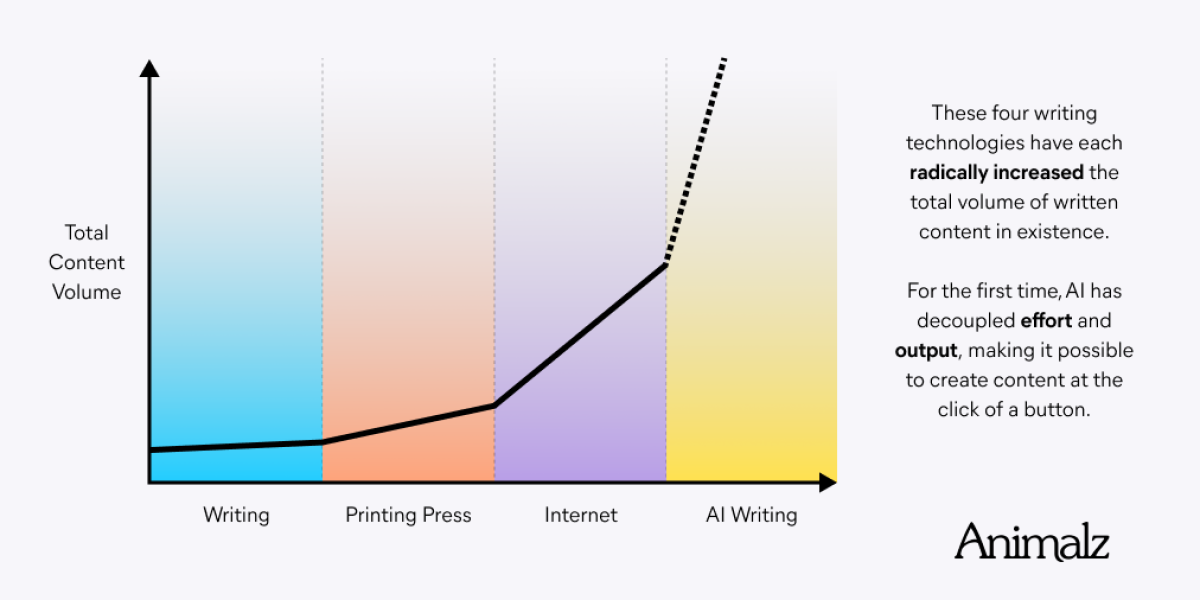You and I are at the dawn of a new era in content marketing: the age of generative AI.
And changes like this almost always begin with more questions than answers.
How much should we rely on AI-generated content? What are the risks and benefits? In a post-ChatGPT world, how will content creation change?
We’ve collected our resources and insights to create a one-stop survival guide for anyone making their way through this AI transition.
Armed with this knowledge, you can develop a thoughtful approach to AI-generated content that leverages the strengths of both humans and machines.
With an adventurous spirit and a little adaptability, AI content might become your superpower for creating high-quality content at scale.
A Guide to the New Era of Content Marketing
How to Begin Your AI Journey
To chart your course through the AI transition, start with your destination in mind. Why do you want to experiment with AI in the first place? Your answer to this question colors your next steps, like the content generation tools you choose and how to work AI content into your marketing strategy (more on that later).
Do you want a library of personalized content that resonates with your users? Do you want fast, high-quality ad copy that gets you in front of the right leads? Are you hoping to position yourself as a trusted industry authority?
Even as someone involved in tech, I was admittedly slow to dabble in generative AI. I wondered how AI could make content better and if it was worth the trouble in the first place.
But it was too hard to ignore the promise of improved efficiency — and then there’s the dizzying variety of tools. Wordtune helps you spice up existing content in seconds flat. Copy.ai churns out hundreds of clever copywriting ideas and creates quick blog post drafts. Writer creates content aligned with your company’s unique style guide.
I could practically retire.
If, like me, you find yourself a little resistant to adopting AI, I can confirm it’s worth the effort. As Gilbert Chesterton wisely pointed out, “An inconvenience is only an adventure wrongly considered.”
Deep dive: What Marketers Need to Know About AI Content
How to Use AI in Content Marketing
As you dip your toes into the waters of AI-generated content, watch for opportunities to incorporate it into your marketing content and strategy.
Do you need personalized ABM campaigns? Faster blog post drafts? Programmatic SEO? Take note of any areas in which it may help free up your team to work on high-level tasks. Then, follow a few steps to increase your odds of great output.
Play to AI’s Strengths
AI’s strengths are often the inverse of your own. AI can produce content en masse, while you can inject it with factual support and lived experiences. AI can offer endless new ideas with no hint of writer’s block, while you can cook up strategic plans and put ideas into action.
So, give AI jobs it can execute. Choose topics without a complex narrative, and make sure your prompts don’t reference specific brands or products. Sharing who your audience is and the desired outcome of the content can also be helpful. Are your readers mid-level managers? Do you want them to sign up for a free trial? Say so. Offer clear and specific context when possible.
Then, seed your prompt with the exact information you want in your content, like facts and statistics, outline structures, and calls to action. Remember, your output is only as good as the prompt you provide.
Assume Nothing
AI will lie to you — and without a healthy dose of skepticism, you might miss it. Unlike you and I, AI generators have read the entire internet. And along with that vast knowledge comes a hefty share of human-fueled bias and inaccuracies.
Assume nothing and fact-check everything. Reviewing and proofreading all content will also help content creators avoid ethical problems like biased content and plagiarism.
Experiment With Your Human-to-AI Ratio
In the era of AI-generated content, there are human-writer purists, AI maximalists, and everything in between. How much you depend on AI in your content creation process is up to you. There isn’t a perfect formula for every scenario, but in our experience, the best ratio of human-to-AI involvement is usually about 50/50.

Think of human writer involvement vs. AI output like a content recipe. Some occasions call for a little more of one spice than the other, but the recipe stays relatively consistent. Experiment to find your best mix.
Deep dive: The Content Cyborg: How to Use AI Writing Tools in Content Marketing
How to Build Your AI Tool Stack
In my experience, testing tools is the most time-consuming part of working with AI. Not that it isn’t fun (it is). But it’s challenging to find a rhythm when you’re bombarded with new-and-slightly-different options every day. Fear not: I’ve got a shortcut for you.
Over the past two years, we’ve run experiment after experiment with AI generators. In the process, we’ve whittled our list of go-to tools down to a few favorites by use case:
Tool Best Use Case ChatGPT Brainstorming, creating personalized content, and conducting all flavors of research. Copy.ai Whipping up ultra-creative marketing copy and short-form content, like social media posts, product descriptions, and article titles. Jasper Writing long-form content, like landing pages or blog posts. Wordtune Rewriting existing content in a fresh way, with options for tone adjustments, rephrasing, and adding spiciness to content via jokes and stats. Writer Writing content that aligns with your company’s style guide and preferred language. DALL·E 2 Brainstorming creative visuals or generating variations of your existing artwork. Midjourney Generating creative, polished images for blog posts and social media. Low barrier to entry with many customization options.
Why ChatGPT May Become Your Default Tool Anyway
Most generative AI tools offer unique front-end experiences built on the same tech as ChatGPT (GPT-3 or GPT-4), so it makes sense to use ChatGPT as your starting point.
Why? Flexibility is the name of the game as you get started with generative AI. ChatGPT is an open playground to get familiar with natural language processing tools before you commit to a niche service. You aren’t capped in terms of daily free uses, and it isn’t pre-configured for specific use cases, like creating marketing copy or refining existing content.
Deep dive: GPT-3 is the Sparring Partner You Didn’t Know You Needed
How to Navigate the Risks of AI-Generated Content
You’ll be hard-pressed to find a content use case artificial intelligence can’t help with. But like anything else, AI isn’t without risk. Your job isn’t to avoid risk entirely, but to understand what’s ahead of you, then decide which use cases make the most sense.
Google: Google’s current guidelines appear AI-neutral, favoring helpful content above all. While penalties are unlikely, they aren’t impossible.
SEO channel: There’s no question that AI will change SEO. Our theory: SERPs will become saturated with AI copycat content. This will diminish SEO returns, giving way to new ranking preferences like thought leadership.
Hallucinations: AKA completely made-up facts. Content generators have the singular goal of writing, so new facts and sources fall by the wayside.
Legal: AI generators often create biased and discriminatory content. They may also cause copyright issues and data leaks. Some tools are already exploring how to detect bias, so we expect to see more on this in the future.
Mediocrity: On their own, AI generators may spit out soulless, been-there-done-that content that lacks any originality.
Most of these risks are already present in content marketing to some degree. Fortunately, a bit of human oversight will go a long way in mitigating their impact on AI content.
Deep dive: The 6 Risks of AI Content
How to Adapt: Predictions for the Future of AI-generated Content
Now that AI-generated content is here, there’s no going back. The industry is charging ahead at full speed, and AI will likely change SEO and content marketing significantly. While there’s no saying for sure what’s around the corner, we’re making a few predictions:
AI tools will catch on fast: AI tools are cheap, widely accessible, and require minimal technical savvy. They productively knock out many difficult parts of content writing, like thinking of clever subject lines or following company style guides. They’re just too good to ignore.
AI will take over simple content: Consider the average reader of an SEO blog post. In all likelihood, they’re on the hunt for quick info, not a novella. ChatGPT shines when it comes to brief, creative content, making it perfect for the average SEO post.
SEO will look very, very different: With questions answered directly in search queries by AI-powered features like the Google Bard chatbot, zero-click searches will become commonplace. Large language models (LLMs) may also cause fragmented search engine preferences, diminishing the Google search monopoly. SEO will change post-AI, and it’s up to us to adjust.
Bylines and sources will become more important: Google already values subject expertise, authority, and trustworthiness. But in a world where AI can create content with almost no involvement from a human (and readers are already skeptical of online content), there may be a growing preference for content from trustworthy publishers, people, and brands. Sharing verifiable details about the author of your content will likely become a competitive differentiator.
Humans will focus on strategy: As AI content generators take over low-grade tasks involved in content marketing, humans can dedicate more time to strategy. Rather than writing listicles and brainstorming social captions, content marketers can act as curators and directors, focusing on high-level creative and strategic tasks.
So, how can you adapt? Dive in. Experiment with AI and different types of content, continue to build topical authority by sharing valuable content, and keep real writers in the driver’s seat as you work with AI tools.
Deep dive: 6 Predictions About AI in Content Marketing
How to Outsmart a Saturated SERP
If, as predicted, SEO channels become inundated with AI copycat content, standing out on the SERP will be more challenging than ever.

Adapting may mean leaving the days of pure keyword research behind you and trekking ahead into new territory. We have a few recommendations for getting started:
Diversify your content: Keep adding SEO content, but experiment with new content approaches, like backlinks and social media. Try your hand at thought leadership content that adheres to Google’s preferences for subject expertise, authority, and trustworthiness.
Prioritize information gain: Remember that AI content can’t conduct primary research — it depends on what’s already on the internet. Use your strengths to create a quality gap between your content and the copycat content that may saturate future SERPs. Consider how your content will add to the discussion in a way AI can’t, like addressing neglected topics, sharing surveys, and sourcing quotes from experts.
Same story, but with a twist: Two blog posts with nearly identical information can still deliver completely different reading experiences. Create a different feel to the same information by playing up your brand’s personality, highlighting a different opinion, or telling your story through the lens of a new metaphor.
Deep dive: The Search Singularity: How to Win in the Era of Infinite Content
Embracing the AI Revolution
Is AI-generated content inherently risky? Yes. But foregoing generative AI may be more perilous. As AI becomes a staple in marketing strategies, you can start now and claim the prize of early adoption: embedding personalization into your marketing, experimenting with new channels, and building a library of ranking articles and backlinks before your competitors.
This approach will cement your trustworthiness and credibility for all future content, allowing you to harness the AI revolution to build your traffic empire.
Deep dive: GPT-3 and How it’s a Revolution for Content Marketing
